The implication of this is that inflation may remain higher for longer and so interest rates will have to be pushed higher and kept at these higher levels for longer. Bond yields have been on the rise again with expectations for them to level out later in the year.
In the UK, economic forecasts have improved as energy prices have started to fall and consumer confidence has picked up, if only slightly. Construction activity has shown a continued fall in residential developments, but an increase in the commercial sector as recessionary fears appear to fade.
The Bank of England has said it does not anticipate further rate increases are required, going against the market consensus and the ECB and Fed. The BoE base rate currently sits at 4%, while futures markets forecast this will sit around 4.6% by December. Some investors believe that markets are overestimating where rates will end up – a theme we have seen this year already.
Elsewhere, with the Chinese economy now re-opening tensions with the US are increasingly strained. Despite this the two countries conducted over $700 billion of trade in 2022, highlighting how much these economies rely on each other.
European markets have surged higher this year despite an ever-challenging backdrop. Whether this is simply making up for lost ground last year or an over-optimistic approach by investors, this growth leaves little room for any disappointments.
The theme of high volatility has continued and is expected to do so until the second half of the year.
Areas of focus
- European equities continue to rise but whether this momentum can be sustained is key.
- Government bond yields are also rising as economic data points to higher inflation for longer. Investment conditions are set to improve later in the year, although this cannot be guaranteed.
- Corporate bond yields have dropped but are still an attractive investment, especially at the higher quality end.
- US growth stocks have outperformed value investments this year but the conditions for value-based performance to improve are present. A diversified combination of both styles with individual stock picking represents the best bet, in our view.
- Despite the Chinese economy opening, long-term regulatory and political risks make individual stock selection in China key.
- The energy sector is still looking likely to outperform this year.
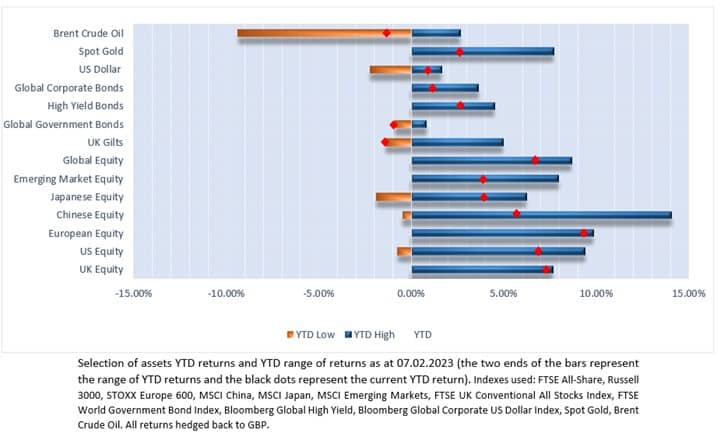
China
There have been lots of “balloons” flying over the US recently… Despite this increasingly testing relationship between the US and China, investors have been buoyed by recent Chinese economic data.
Manufacturing data shows factory activity has picked up and is at the highest level for over 10 years. So, does this mean Chinese stock markets are now a good place to invest?
Investors like to jump on any piece of positive news from China to say now is the time to invest. We saw this in both 2021 and at times in 2022. If you had invested in any one of these periods, the calendar year performance would have been 4.80% in 2021 and -15.13% in 2022.
China as an economy has many moving parts and as we have seen before, economic growth and equity market growth are not necessarily correlated. While economic activity may be picking up, longer term issues such as regulatory and political interference and a struggling property sector still weigh on asset values.
Global demand for Chinese exports is waning after disruptions from recently ended zero-covid policies, dropping by 9.9% in US Dollar terms. Businesses are attempting to bring trade back by attending overseas business events (at the government’s expense). Long-term the relationships may be damaged as importers have already looked to alternative suppliers to shore up supply chains.
Chinese GDP growth is still expected to be 6% this year, which sounds high relative to other countries. For China however this is low, as between 1992 and 2022 GDP growth averaged 9.04%.
China’s full reopening will benefit other economies as supply will increase and this should help to bring prices down. One example of this is the global supply of Cobalt. A key material in the production of batteries for electric cars, the price has dropped from its high of $40 per pound to $16 per pound. China controls 77% of global refining capacity and the re-opening of the Chinese economy has increased supply to the market, bringing the price down. One downside is that oil prices are likely to rise as activity picks up.
Chinese equity certainly still holds merit for being included in a portfolio, as both a diversifier and a source of potential returns. The yield advantage that government bonds had has disappeared and rates don’t look likely to rise anytime soon. In fact, in our view rates are likely to relax further to support the struggling property market. If consumers start to purchase properties again and developers can complete existing projects, then this will help to boost economic growth.
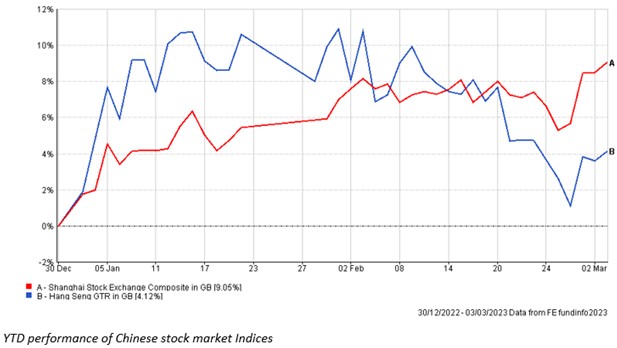
UK
In February, a December GDP figure of -0.5% brought some positive news – the UK economy narrowly avoided a recession in 2022. However, investors should be prepared for further volatility, as economists are still predicting a recession in 2023, although it is expected to be less painful than first anticipated.
In line with expectations, the Bank of England raised interest rates by 0.5% at the start of February, bringing the UK base rate up to 4% – a 14-year high. After more than 12 months of high inflation, there are signs that price pressures are starting to ease, as CPI fell to 10.1% in January. This was mostly caused by a fall in wholesale energy prices.
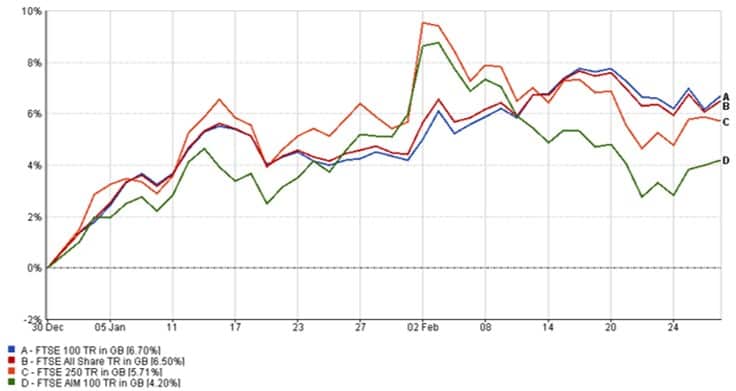
In the month that the FTSE 100 closed above 8000 for the first time in history, UK equities generally performed well, despite a somewhat challenging economic backdrop. UK large-cap stocks contributed to most of this growth. The FTSE 100 increased by 2.40% in February while the FTSE100 AIM lost 1.68% over the same period. The FTSE 100, heavily dependent on the natural resources sector, reacted well to record-high profit announcements by oil companies during the month. China’s relaxation of COVID restrictions also eased some of the supply side pressures faced by the UK in recent months.
Despite the FTSE 100 hitting an all-time high in February, investors pulled £962m from UK-focused equity funds during the month. This marks a 21-month sell-off for UK equity funds. Investors have primarily shifted towards fixed-income funds, which saw £834m of inflows in February.
UK government bond yields increased at a steady pace in February, but the yield curve remains inverted (meaning longer term interest rates are predicted to be lower than short-term rates). The yield on UK 10-year gilts reached 3.84% on the last day of February. Yields have since pulled back to around 3.5% in early March due to positive news from the Bank of England.
In early March, the London Stock Exchange suffered a substantial blow. CRH, a FTSE 100 building materials giant, announced it would shortly be leaving the LSE in favour of a US primary listing. CRH believe that a US primary listing will bring increased commercial, operational and acquisition for the company. On the back of this announcement, CRH share price soared 7%.
PM Rishi Sunak has recently tried to reduce red tape to make London a more attractive destination for companies to list their shares. However, in recent months, several companies have either rejected or considered leaving the exchange.
Europe
The latest inflation readings for the bloc show only a 0.1% fall between January and February, currently sitting at 8.5%. Like many other major economies, investors are now expecting interest rates in the bloc to settle at a higher rate than previously expected.
Despite falling inflation overall, the data from individual countries is varied. Inflation in France, Germany and Spain rose over the past month, with inflation in Latvia reaching more than 20%.
Europe was arguably most affected by energy prices last year and at the mid-way point were underperforming most other markets. Since last March most developed European markets have performed better than their global counterparts. This price momentum has come from improved economic news and from a lot of negative pricing in the first half of 2022.
The risk here is that if earnings disappoint, which will be a key factor in determining individual equity direction, and economic news deteriorates then there is not much room for disappointment.
Cyclical stocks have outperformed their defensive counterparts, and while this generally is a sign that an economy is moving into an expansion phase, looking at other economic fundamentals suggest this may not be the case just yet.
European bond yields, like UK and US bonds are currently inverted. This is generally seen as a sign of economic downturn and in this circumstance, cyclical stocks tend to underperform as their earnings are sensitive to the state of the business cycle.
Furthermore, any downturn will drive company earnings down, and we have not yet seen any revisions to values based on lower earnings estimates.
Yields on government bonds have continued to rise with no respite. The ECB is expected to pick up the pace of unwinding its bond holdings, in a bid to continue to tighten financial conditions and liquidity for European governments. At the same time European governments have been issuing new debt to refinance existing borrowings.
Last year investors were concerned about the level of Italy’s debt, which reached almost 150% of GDP in December (compare this to Germany, where the debt to GDP ratio is around 70%). Investors were concerned about the financial stability of Italy, and this caused the spread between Italian and German government bonds to widen to a high of 2.5% (German bonds are seen as a high credit quality and comparisons are made between the yield on these and the yield on other European debt to gauge the credit risk of another country).
Recently this spread has reduced to 1.8% as the credit risk of the country has reduced. New Italian Prime Minister Giorgia Meloni has become more cautious on public spending, in contrast to investors’ expectations. This has helped to settle investors.
However, when interest rates rise yield spreads between assets of different risk levels tends to widen. In this case we have seen the opposite which has puzzled investors. One likely reason is that Italian bonds are trading at higher yields which have attracted high-yield investors. This demand over lower yielding German bonds has helped to subdue the magnitude of any price drops.
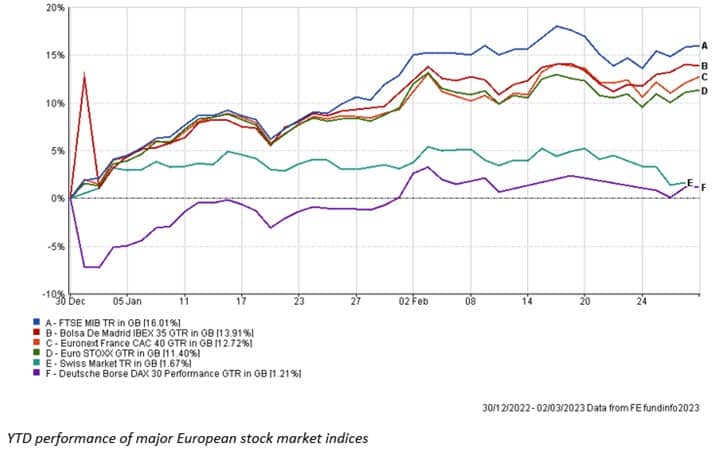
US
Growth stocks have started the year above their value counterparts as investor optimism tries to recover some of the heavy losses experienced last year. Markets have once again reiterated the theme of not buying the dip. This is because the dip can get worse, and we are seeing this in bond markets.
With the labour market tightening further and the Fed’s preferred measure of inflation showing that price increases will remain elevated for longer, both equity and bond markets have retreated.
Over the past decade value stocks have underperformed growth stocks. In a low interest rate environment, companies with low current cashflows and high future predicted cashflows were able to grow quickly and the value investors placed on them was higher. But in 2022, with interest rates and inflation both higher, we saw the opposite. Investors sold off these now-expensive stocks and moved to underappreciated sectors of the market.
So far this year growth has continued to outperform value, but will this trend continue? The macro-economic environment points to no. Inflation will remain elevated and so too will interest rates. It isn’t a case of avoiding one style and solely investing in the other, however – investors have different objectives and using different styles helps to provide diversification within a portfolio. It is a case of understanding why sectors and styles perform as they do and where they might be headed.
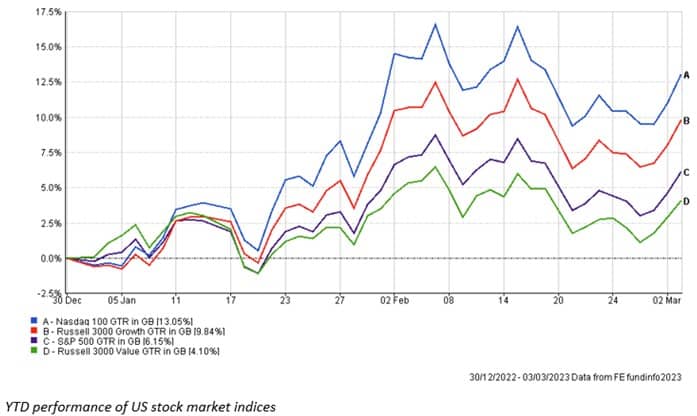
The chart above shows the Russell 3000 Growth and NASDAQ 100 performing the best YTD. We can see that since the start and middle of February that the upwards momentum has stalled due to recent labour market and Fed inflation comments.
The US jobs market, which has been a key metric over the past year, continues to be tight. Despite the unemployment rate being historically low (3.4%), US companies have however reported improved hiring conditions.
What this means for investment markets is if companies are struggling to hire workers, in order to fill a vacancy, businesses will have to increase wages to attract workers. This wage inflation will spread into price inflation as demand for goods will not drop as consumers have more disposable income. Inflation will therefore not fall as much as intended and so the Fed will have to increase interest rates to higher levels to bring inflation down.
If US companies are reporting easier hiring conditions, then wage inflation may not keep increasing as expected, aiding in price inflation coming down. This is only an increment step and the reflection in economic data to support this will be needed.
The big question is that if unemployment is historically low, how can hiring conditions be improving? And will unemployment continue to fall? If this is the case, then an even tighter labour market will most likely prompt the Fed to increase interest rates further. However, if the improvement in hiring conditions is due to consumers re-entering the labour market, this will lessen the case for increased rate rises.
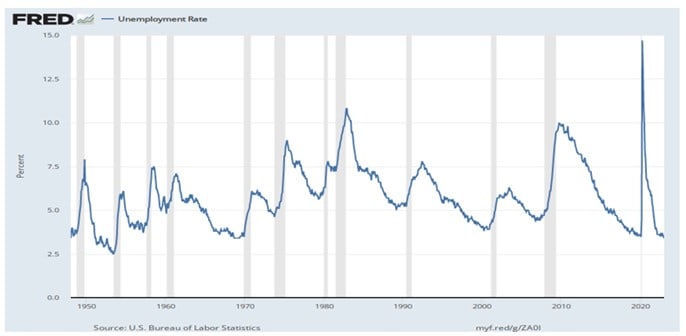
In the fixed interest sector, bonds had started the year with intent. That is to not repeat the negative slides of last year. All the warm Christmas feelings investors were having helped to initially push bonds up by 3-6%. The fear that interest rates may keep going up has, as with equities, halted their upward momentum.
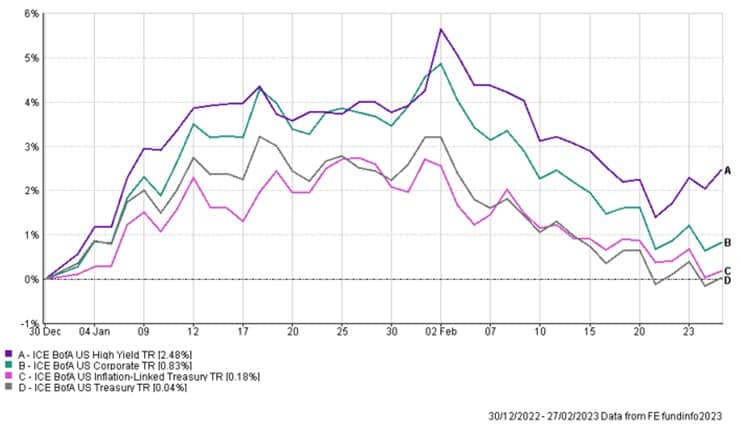
Government and inflation linked treasuries are now just about back to neutral. The yield on the 2-year treasury (4.791% at close on 27/02/2023) is back to its 52-week high, and the highest level since 2007. Since the start of February this has risen by 16.63%.
The US treasury 10-year yield (3.918% at close on 27/02/2023) is below the 2-year yield currently, but it has risen by 16.04% since February as well. This inversion of the yield curve highlights investors views of a likely recession, even if mild; short-term interest rates will be higher than long-term interest rates; and inflation will fall in the future but remain higher presently.
Initial reactions to US inflation figures falling in December were optimistic, and the reality that the economic situation is not clear-cut has now sunk back in, in line with our expectations. The Fed’s preferred measure of inflation – the core monthly personal consumption expenditure, which excludes volatile food and energy prices – rose by 0.6% in January. This was higher than initial forecasts.
Despite falling energy prices inflation will likely remain stubbornly high. Long-term structural issues underpin an atypical economic environment and short-term data won’t be enough to convince markets that rates will fall.
Looking forward, based on US interest rate future markets, rates are expected to hit 5.4% in July, up from the current 4.5% to 4.75%. An interest rate cut is forecast but not until the end of the year.
If labour conditions tighten and core PCE rises, then these forecasts will also increase. Fed members have forecast the rates to end the year at 5.1% but some feel this is too conservative.
There will be value in bonds this year, but the question is – when the right time is to invest?
Robert Dougherty, Associate IFA
March 2023
This article is not a recommendation to invest and should not be construed as advice. The value of an investment can go down as well as up, and you may get less back than you invested.